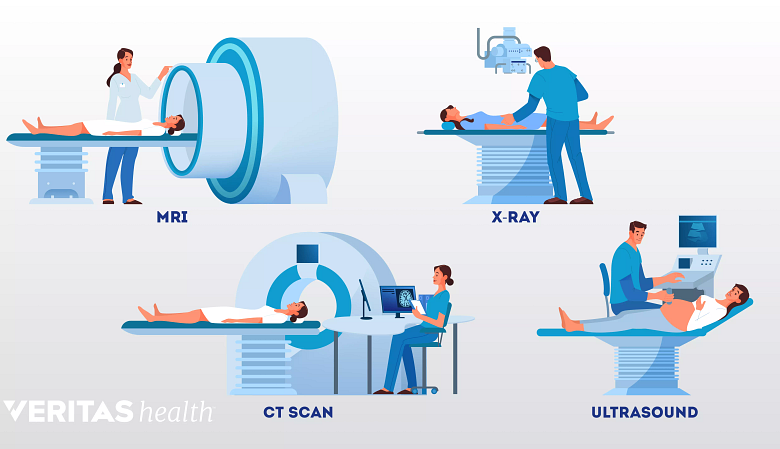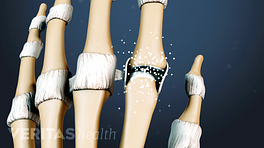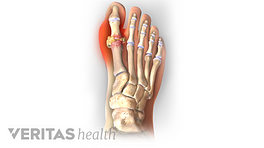Psoriatic arthritis can be challenging to diagnose. Classic signs of the disease, such as pitted fingernails and swollen joints at the ends of fingers, are not always present.
Diagnosing psoriatic arthritis may involve the use of medical image testing.
There is no one blood test used to diagnose psoriatic arthritis. It is a diagnosis of exclusion, which means physicians must rule out all other diseases that can produce similar symptoms, such as rheumatoid arthritis, reactive arthritis, and ankylosing spondylitis. Diagnosis may require a medical history, physical examination, medical imaging, and lab testing.
In This Article:
- What Is Psoriatic Arthritis?
- Psoriatic Arthritis Symptoms
- Psoriatic Arthritis Causes
- Psoriatic Arthritis Diagnosis
- Psoriatic Arthritis Treatment
Medical History
The physician will ask about the symptoms and when they began. He or she will also ask if any of the patient’s family members have experienced similar symptoms in the past. Patients are advised to report gastrointestinal issues and eye problems, as these may be related to psoriatic arthritis and other autoimmune diseases.
Physical Examination
The physician will examine the joints to look for tenderness, swelling, or stiffness. These are signs of inflammation and may indicate the presence of arthritis.
The physician will check the skin for signs of psoriasis, and may look at the scalp, navel, and groin, where psoriasis can sometimes go undetected. Fingernails and toenails will also be examined for signs of irregularities, such as nail pitting.
Medical Imaging
Several different types of medical imaging are used to look for signs of psoriatic arthritis, including inflammation and damage to joints.
- X-rays can show irregularities involving bones. For example, they can show a loss of normal bone tissue (bone erosions) as well as abnormal bone growths, such as bone spurs (enthesophytes and osteophytes). X-rays can also show if the space between the bones of a joint is abnormally small. An abnormally small space is a sign of damage to cartilage and soft tissues. When psoriatic arthritis is in its early stages, x-rays may appear normal.
- Ultrasound can show inflammation of the joints soft tissues. For example, the delicate tissue that surrounds a joint, called the synovium, is normally just a few cells thick. An ultrasound can show if the synovium has become thicker and inflamed, a condition called synovitis. Ultrasound can show other signs of inflammation, including an increase in normal blood flow, enthesophytes (bone spurs), and early signs of bone erosions. Ultrasound, particularly Doppler ultrasound, can detect joint changes in the early stages of psoriatic arthritis.
- Magnetic resonance imaging (MRI) shows a more detailed picture than an x-ray, including the bone as well as surrounding soft tissue. In addition to changes to the bones, and MRI can show inflammation and other changes to soft tissues, including the joint’s entheses. MRIs are especially helpful in detecting sacroiliitis. In general, an MRI is more expensive and takes longer than an x-ray or ultrasound evaluation.
In addition to medical imaging, your physician may order lab tests.
Lab Tests
A doctor may order lab tests to help confirm or rule out the diagnosis of psoriatic arthritis. Common diagnostic lab tests include:
- Erythrocyte sedimentation rate (ESR) and C-reactive protein (CRP) tests measure inflammation in the body. Higher than normal inflammation can indicate psoriatic arthritis or another inflammatory disease.
- Rheumatoid arthritis factor (RF factor) and citrullinated peptide (CCP) antibody tests can help rule out or confirm rheumatoid arthritis (RA). Rheumatoid arthritis is often confused for psoriatic arthritis and vice versa. If a lab test detects proteins called rheumatoid factor and/or citrullinated peptide antibodies, it indicates a possible diagnosis of rheumatoid arthritis.
- Anti-nuclear antibodies (ANA) test identify ANA proteins, which can be found in the blood of people who have autoimmune disorders, including psoriatic arthritis.
- Genetic testing can detect one or more genes associated with psoriatic arthritis. Gene testing may help support or rule out a diagnosis, though it is not necessary.
- Joint fluid analysis, which involves using a needle to removing a small amount of fluid an affected joint. This test can help diagnose or rule out gout and other types of arthritis that can cause swollen, inflamed joints.
The combination of medical history, physical exam, medical imaging, and lab testing can help a physician rule out or make the diagnosis of psoriatic arthritis. The sooner an accurate diagnosis is made, the sooner treatment can begin.











